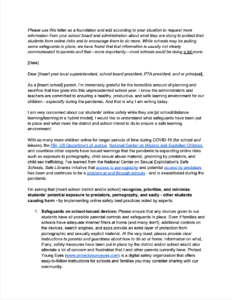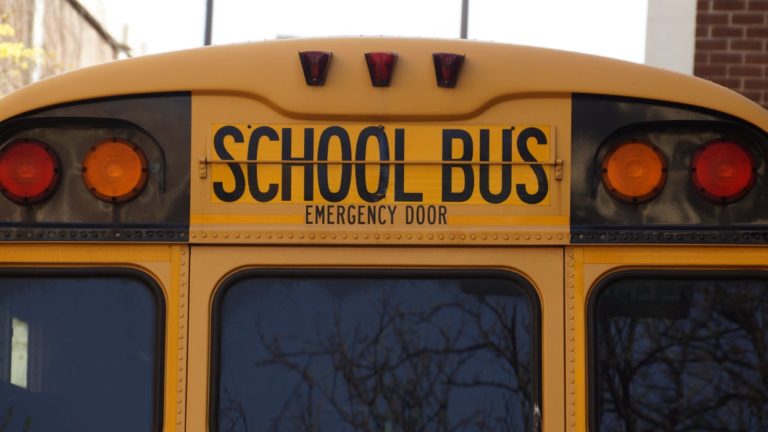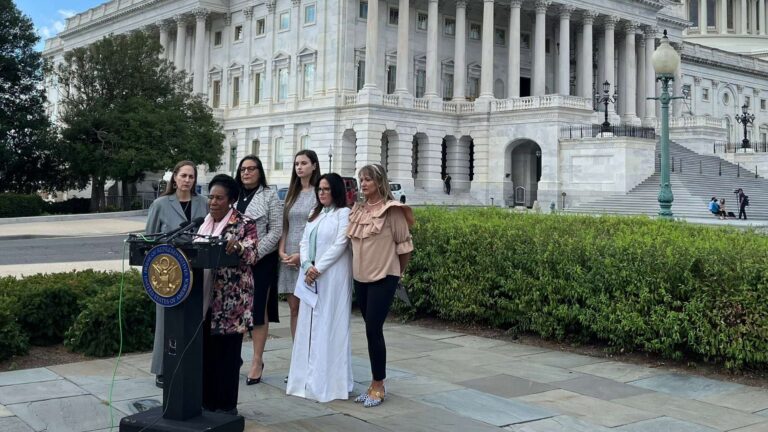Covid has laid bare many social truths—not least how truly essential our teachers and our schools are to the health and wellbeing of our children, our families, our communities. Parents and guardians across the nation developed a deeper appreciation for the many challenges our teachers face as they were thrust into the role of teacher last spring. Eyes were opened (often through tears of frustration) at just how much is expected of our educators.

As I’ve been preparing my three oldest children to virtually join their public elementary school peers (all giddy with their new, shiny Chromebooks), I’ve certainly felt a stronger sense of gratitude, camaraderie, and shared responsibility with teachers and administrators for ensuring a healthy, productive, and safe learning environment for our children—especially during the pandemic.
One critical area we must work together to improve is students’ online safety.
We must work to improve #OnlineSafety for our children during #VirtualLearning. Here's how: Share on X
Why, when there are so many other challenges, should schools prioritize cybersafety? Is access to pornography and potential access by predators really such a problem at schools? Yes: it’s a much bigger problem than most teachers (and certainly parents) realize—and distance learning is only exacerbating the dangers.
At its best, technology facilitates creativity, fosters connections, and expands access to content, but it can also expose our children to physical danger, emotional distress, and mental harm. With so many more children online for longer periods of time during COVID-19 (for school and leisure), the FBI, US Department of Justice, National Center on Missing and Exploited Children, and countless other experts have issued warnings that the pandemic is expanding online risks such as exposure to pornography, child sexual abuse material, grooming by predators, and child sex trafficking.

Schools must recognize, prioritize, and minimize students’ potential exposure to predators, pornography, and—sadly—other students causing harm by implementing best practices for online SAFETY:
Schools must recognize, prioritize, and minimize students' potential exposure to predators and pornography by implementing these best practices for #OnlineSafety. Share on XSafeguards on school-issued devices and platforms
Age-appropriate research databases
Filtered Internet and Wi-fi (including hotspots)
Education for parents
Teacher training
Youth empowerment
Safeguards on School-Issued Devices
For a long time Chromebooks and iPads being handed out to students to support distance learning were placed in children’s hands with no parental controls or other safeguards in place. Even if families and schools have adequate Internet filters at home (and many don’t), additional controls on the devices, search engines, and apps provide an extra layer of protection from pornographic and sexually explicit material. Schools should be turning on parental controls before giving devices to students. If they don’t have the bandwidth or have already distributed them, schools should provide clear instructions to parents and guardians about how to do so at home. Information on what, if any, safety measures have been put in place by the school to families would also alleviate a lot of concern and frustration.
NCOSE placed Google Chromebooks on the 2021 Dirty Dozen List precisely because they failed to turn on safety features for Chromebooks distributed to schools. And we asked concerned citizens like you to take action and call on Google to do better.
YOU took action. And YOU got results!
VICTORY – In late June 2021, Google announced they are making significant changes to Chromebooks and other products used for K-12 education. Read about those updates that went into effect worldwide September 1, 2021.
- Do you know of other safety problems on devices given out by schools? Let us know and help be part of the next victory!
- Safeguard your students’ devices and apps by visiting our ally: Protect Young Eyes. Find the devices or apps your students are using, read about the risks, and follow their step-by-step instructions to turn on privacy and controls. Please share this with your teachers and families!
Age-Appropriate Research Databases
(this section edited for clarity on 11/02/20)
Is your school (or partner library) using EBSCO or Gale as its research databases? If so, your students may be exposed to sexually explicit material and even pornography, including live links to pornography and prostitution/escort websites and articles promoting risky sexual behavior (group or hook-up sex, incest, and “sugar dating”). We’ve seen articles with ads for sex toys in databases marketed toward kids as young as 12. And get this: these databases contain loopholes that bypass Internet filters. Educators and parents are paying closer attention and calling out these corporations for including material that is harmful to minors. Parents in several states are pushing legislation to close the loopholes and set basic standards for these databases. School boards, administrators, and teachers need to be aware of these problematic databases and consider turning them off until they can prove sexually explicit material and pornography has been removed by the corporations.
- For these reasons, EBSCO was on our 2020 Dirty Dozen Watch List. (Not this webpage is not recently updated.)
- Learn (and see) what EBSCO and Gale believe is age-appropriate material: visit our ally organization Pornography is Not Education.
- Do you know of on-going issues in school research databases? Let us know!
Filtered Internet and Wi-fi (including hotspots)
Schools that receive federal E-rate funding are mandated to comply with the Children’s Internet Protection Act (CIPA) to monitor how students are using the Internet, use software that blocks access to harmful material, and implement an Internet safety plan. Coronavirus complicates this, but school districts can and should find ways to provide filtered Internet access to students (our district ensures filtered Internet when kids log into devices with their school email). If school districts are working with ISPs and telephone carriers to provide discounted or even free access, they should require defaulted filtering.
Education for Parents
We’re in this together. Help us help you by giving us the information we need to keep our kids safe. Please educate families about online risks and how to mitigate them. I know school districts and schools around the country are hosting webinars and teaching sessions about technology during distance learning: ensure that each session has a segment and resources on device and platform safety controls (including for Zoom!). Have the PTA sponsor a special session for parents regarding Digital Safety. At the very least, be very clear with families what platforms and websites their kids will be using, provide them their children’s passwords, and direct them to resources they can use to have age-appropriate conversations with their kids at home about body safety, harms of pornography, digital citizenship, etc.
- The Safeguard Alliance, a project of the National Center on Sexual Exploitation, has a library of resources on various topics related to the sexual exploitation and abuse of minors and what parent and educators can do to about issues like sexting, child-on-child sexual abuse, pornography exposure, etc.
- Culture Reframed has extensive resources for parents, including their free Parents Program on Porn and Hypersexualized Media for Tweens and Teens.
- This DHS CyberSmartCampaign has short videos that cover cyber safety basics.
- Send them The ABCs of Safe Online Learning, a blog that includes recommendations and resources for families.
- Visit Protect Young Minds website, blog, and guides that includes incredibly useful, easy-to-read information crafted specifically for parents.
Teacher Training
We’ve been hearing of teachers using social media platforms like Snapchat, WhatsApp and TikTok to engage students, when those platforms are known to be pedophile hunting grounds and rampant with child sex abuse material. Do your teachers know the risks of the platforms, devices, and education tools they’re using? Are they clear about protocols and procedures when a student is exposed to or even sharing pornography (including sexually explicit pictures of peers) while completing school assignments, on the playground, or school bus? Do they have the support and training necessary to deal with these potential harms? Digital Safety should be required for all school personnel—and there are many fantastic resources school administrations can use and tailor for their community.
- Readiness and Emergency Management for schools Technical Assistance Center (administered by the U.S. Department of Education’s Office of Safe and Supportive Schools) provides extensive resources, live and recorded trainings, and interactive tools on a wide range of threats and hazards to schools, including ensuring students’ online safety during the pandemic.
- Cybersecurity and Cybersafety for Schools (parents, send this to your schools boards, principals, and PTA and ensure they are implementing these measures)
- Cybersafety Quick Links for Protecting Youth (resources schools can use and share with families and students)
- Common Sense Media includes extensive resources for teachers on types of educational platforms, social media, etc. Has live chats on available for educators on various topics related to online safety.
Youth Empowerment
Part of doing everything we can to protect our kids is to teach them to protect themselves. Does your school curriculum include digital citizenship, cyber security, or critical porn analysis?
In our increasingly tech-reliant education system, lessons around these issues should be required, prioritized, and ongoing. At a minimum, students should be well aware of school policies and expectations around devices (school-issued and personal) and Internet usage. Sooner, not later, is when students should be taught in age-appropriate ways about body safety, recognizing predatory behavior (in person and online), understanding the harms of pornography and what to do if they’re exposed to it, being clear on the socio-emotional risks of “sexting”: sending sexually explicit photos of themselves, as well as the potential consequences—including criminal liability—of taking and/or sharing sexually explicit material or using it to bully, shame, or threaten someone (i.e. “revenge porn”), and most importantly what to do if they feel uncomfortable or threatened.
- Youth Wellbeing Project tailors presentations for students from K–12 to build online literacy
- Partner organization Protect Young Minds has just released a new curriculum, Brain Defense, geared toward 4th–6th grade or 9–12 year olds with purchase options for single classrooms, schools, and multiple schools—as well as for homeschoolers. You can also add faith-based supplements.
- Netzsmart through National Center for Missing and Exploited Children (NCMEC) includes lesson plans for teachers with activities, kid projects, videos, tip sheets, etc. on every cyber-related topic possible (digital footprint, gaming, cyberbullying, sexting, etc.)
- Education World: Promoting Responsible and Ethical Digital Citizens: Article includes links to lesson plans about Digital Literacy and Online Ethics, as well as Think Before You Hit Send.
Is your school making the grade when it comes to your student’s online safety? If not, talk to your boards, your administrators, and your PTA to ensure online S-A-F-E-T-Y is prioritized. Failing to protect our kids in an increasingly digital education system is just not an option.
ACTION: Send this letter to your school board, superintendent, PTA, and/or principal.

*The National Center on Sexual Exploitation’s 2020 Back to School(ing) Campaign aims to equip families and educators with information, resources, and actions they can take to keep kids safe online as vast numbers of students start the school year in a virtual learning environment. Over the four week campaign, we’ll feature the people, organizations, and entities that can have the greatest impact ensuring a safe online learning environment, specifically: families, schools, corporations, and the US federal government. This is Part 2 of 4: School boards and administrators.*



